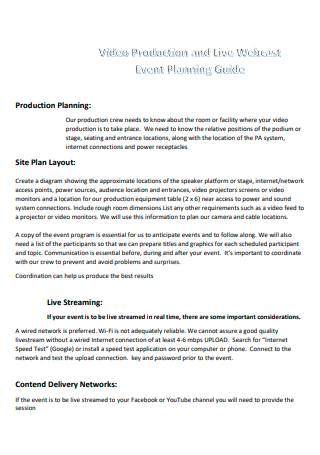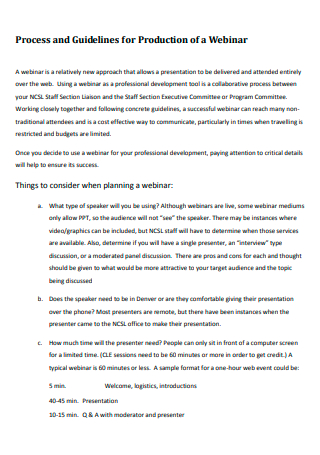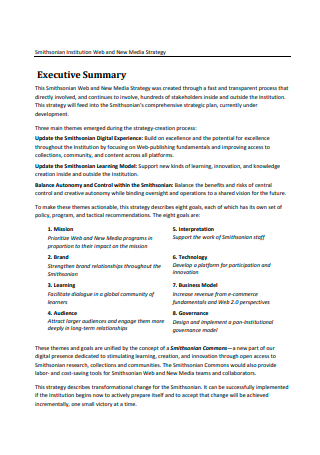3+ Sample Web Production Plan
What Is a Web Production?
A web production entails the complete build-out of a new corporate website from the ground up. The project’s objective is to create a website optimized for on-page SEO and serve as an efficient marketing foundation for your business. According to research, just 50% of small firms have a website.
Benefits of Having a Great Website
According to research, 47% of buyers will check a business’s website before purchasing, regardless of the business’s size. 30% of these individuals choose to purchase from a business based on their preference for their website. Ensure that you are considered a viable business to buy from by completing small business web development today. By doing so, you will significantly profit from increasing your business’s credibility and various other advantages of having a website. Continue reading to learn six reasons you want an excellent website as a small business.
How To Process a Web Production Plan
Before creating a website, planning is critical to ensuring that everything runs properly. Many websites are available on the internet in today’s day and age. It is nearly difficult to succeed without a website that performs appropriately for both the business and its clients. Surprisingly, a lot needs to be done before a website is coded. Numerous processes must be completed for it to be correctly produced. The goal of development planning is to ensure that nothing is overlooked.
-
Step 1: Research and Goal Setting
It is critical to handle thorough research and establish Clear Objectives before commencing any endeavor. By setting goals, you may give your website direction and assist your organization in achieving specific objectives. The planning and goal-setting process may take approximately 1-2 weeks to complete. It is a critical first step toward developing a website that sells. By establishing goals for your website, you can ensure that it has a distinct direction and purpose. This is critical for the subsequent steps. When Creating Your Goals, you should consider how you want the remaining steps to look. Step 1 will seamlessly lead you through the remainder of the process. This step’s research component serves a variety of functions. There are so many models available that it may be advantageous to examine and utilize some of your competitors’ websites. This might assist you in determining what features you want and do not want on your website. Also, it is critical to research the target population you wish to attract. When different age groups visit a website, they may seek something entirely different. Understanding what your audience wants is critical for the remainder of your website’s design. Additionally, it is essential to conduct keyword research for the website. By creating your website with SEO in mind, you will save yourself a great deal of time and effort in the future.
-
Step 2: Plan the Site
The website planning process begins with the creation of wireframe and sitemap. This is a critical phase because it serves as the website’s skeleton. This method usually takes between two and six weeks to complete. The sitemap provides the developer with an overview of how the site will look, how many pages will exist, and how they interact. This is beneficial not only for planning purposes but also for the user experience. A user should navigate a website effortlessly, creating a sitemap. Before you start planning content, a sitemap lets you visualize the site’s structure. After completing the sitemap, this stage’s remaining portion is to develop wireframe or mock-up.
-
Step 3: Design the Layout
The layout’s elements are what give your website its personality. This is the stage at which you can express your creativity through images, videos, and the types of things that customers will notice when they visit your site. This process typically takes between 4 and 12 weeks from start to completion. The project’s duration is determined by the developer’s experience, the amount of time spent on the project, and the developer’s thoroughness. It is critical to refer back to the target audience you desire to focus on during this process. Consider colors, logos, and anything else that can entice visitors to interact with your site. By designing the website’s layout, you strive to breathe life into the website. It should assist the audience in developing an understanding of your business or product. Please remember that this stage does not yet include any written content. That is the following step. The written content is critical enough that it warrants its action.
-
Step 4: Create the Content
This step may occur concurrently with the other phases of Development Planning. A website’s written content is critical to its success. While this stage may occur concurrently with others, it is vital and requires considerable experience. It could take between five and fifteen weeks. A website’s written material will assist a visitor in determining their next moves. It is critical for attracting and retaining customers. There are numerous factors to consider when developing the website’s content. When choosing words, they must be simple to understand. As a general rule, you must expect that not everyone will wish to read terms with a more excellent vocabulary. A website’s terminology should be simple enough for the typical person to grasp. Again, it is critical to consider the target audience, even more so when text provides information to customers. This can influence the choice of words and tone of voice used in writing, which can help set the tone for the content, whether positive or negative. Also, it entails developing attention-grabbing titles and headlines to entice readers. Additionally, it’s a good idea to be familiar with the art of drafting a call-to-action. After reading the website’s content, this is the action you want the user to take. The material should pique customers’ interest in purchasing a product or service. A website with well-written content will be significantly more successful than one without.
-
Step 5: Code the Website
After you’ve generated all of the components of your website, you’re ready to begin building the website itself. Typically, coding starts with the homepage and progresses to all other pages on the site. The sitemap is used to ensure that everything is coded correctly. The coding stage may take between six and fifteen weeks, depending on the amount of material and the complexity of your website. Additionally, frameworks and CMS must be installed to ensure that everything fits on the server throughout the installation process. You don’t want to use all that time and effort only to discover that it doesn’t fit. Once the website has been built out by the sitemap, it should be tested before proceeding. If everything works correctly, the remaining information and formatting should be added. This stage necessitates a thorough understanding of the technology being used. Indeed, even if you want to undertake most of the work yourself, you should consider hiring a developer to ensure everything works as planned. While coding, keep variables like SEO, CMS plugins, and any other tools you may need to evaluate and test the website. Consider these points now to save time and energy later. By keeping SEO in mind, you’ll achieve better results and increase the number of people who see your page. Anything worthwhile is worthwhile when done well.
-
Step 6: Test and Launch
Before starting a website, it is critical that real users thoroughly test it. All links and content should be tested to ensure they function correctly. Not only is it essential to try all of the buttons and other elements of the site, but it is also critical to test what users think. User testing can ensure that the website provides users with the required information to pass the test. Again, there are methods available to decide whether anything should be changed. Ensure that all written information is error-free, including spelling and punctuation. If your website includes forms, check that these function properly as well. These may be critical methods for users to contact you or sign up for alerts and messaging. Without these components functioning correctly, it can be pretty tricky for the user and you to create a successful website. Check the website numerous times, not just once. When you are sure that everything is operational, you can launch your website online. Finally, when it comes to launching, you are prepared and may submit your application to the server.
FAQs
What is a web strategy?
A site plan is a simple diagram or outline of the content you intend to include on your website—the pages you intend to build and the information that will be included on each page. It enables you to see all of the pieces before assembling them. The most straightforward site plan is a diagram showing your website’s navigation menu.
What is the structure of a website?
The structure of your site refers to how the many pages are connected via internal links and their hierarchy. It is the organization and presentation of the information on your site so that the algorithm can comprehend its context.
YouTube is a website, isn’t it?
YouTube is a free video-sharing website that simplifies watching online videos. YouTube was founded in 2005 and has grown to become one of the most popular websites on the Internet, with guests watching around 6 billion hours of video each month.
There is no more suitable time than the present to begin developing your small business’s website. However, as a small business, you must consider the critical nature of having a high-performing website. A website can benefit you in various ways, but it will be far more advantageous to your business’s growth if appropriately designed. Consider this. Would you trust a poorly designed website and be extremely difficult to browse enough to make a purchase? Most likely not. That is why it is critical that your website exists and looks and operates effectively.




